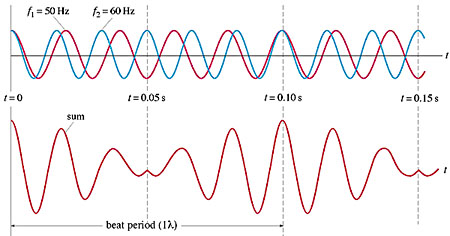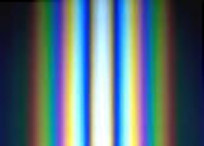Light and Sound
Interference occurs when two waves of very similar frequency and amplitude occupy the same physical space. Since the medium propagating the waves can only be at one point, regardless of how many waves are passing that point, the amplitudes of the waves must be combined algebraically. So, we can have either constructive interference (amplitudes are added) or destructive interference (amplitudes are subtracted). In class, I demonstrated a "trombone" in which a quite annoying, high-pitched shriek is split and sent through two tubes before being recombined. By changing the length of one of the tubes, I could delay the sound wave traveling through that tube just enough so that it arrived about one-half wavelength behind the wave in the other tube. In other words, I could create destructive interference and show how the volume of the shriek drops noticeably.
 I also demonstrated two tuning forks which produced clear and steady tones when played by themselves, but exhibited very strong "beats" (periodic oscillation in the volume) when played together. This phenomena occurs when two waves of identical shape and amplitude, but slightly different frequency, interfere. Because they have slightly different frequencies (and therefore slightly different wavelengths) one of the waves gradually "gains
ground" on the other, and slowly moves from constructive interference to destructive and back again. The result is a pulsing volume. The figure at right illustrates this. (The top graph shows each sound wave separately; the bottom graph shows the result after they are combined algebraically.)
I also demonstrated two tuning forks which produced clear and steady tones when played by themselves, but exhibited very strong "beats" (periodic oscillation in the volume) when played together. This phenomena occurs when two waves of identical shape and amplitude, but slightly different frequency, interfere. Because they have slightly different frequencies (and therefore slightly different wavelengths) one of the waves gradually "gains
ground" on the other, and slowly moves from constructive interference to destructive and back again. The result is a pulsing volume. The figure at right illustrates this. (The top graph shows each sound wave separately; the bottom graph shows the result after they are combined algebraically.)The other wave phenomena that people can sense directly is light. Aristotle thought that light was an inherent property of fire and other luminous substances. In this view, light does not have a speed (or the speed is infinite) and it doesn't even have a separate existence from the light source; light just is. Many ancient thinkers disagreed with this, however, and noted the way that light can shine though clouds or windows in straight lines which seem to come from the light source. They thought light was a substance which moved from place to place. Also, reflected light obeys the law that the angle of incidence equals the angle of reflection, and this is the same way that hard objects behave if they meet hard walls. (A billiard ball bouncing off a side rail is a good example.) This seemed to be further evidence that light moved.
Galileo, of course, was certain that if Aristotle said it, then it must be wrong. He thought that light must have a speed. Galileo tried to measure the speed of light by standing on a hill with a lantern, and having an assistant with another lantern stand on a hill some miles away so that Galileo could observe the delay between when he opened his lantern and when he saw the return signal from his assistant. But the delay was so short that Galileo realized he was only observing the reaction time of his assistant. He concluded that if the speed of light was not infinite, then it must be very, very high. He was right. Light speed is 299,800,000 meters per second (186,282 miles/sec), which is far too fast to be measured by such a method.
 Isaac Newton performed some important experiments on light during the 1670's. He noticed that white light could be separated into colors with a prism...and then the colors could be recombined with a second prism to form white light again. Up to then, it had been thought that colors were imparted to light by the glass they passed through. Newton's experiments demonstrated that color was a property of the light itself, not of glass.
Isaac Newton performed some important experiments on light during the 1670's. He noticed that white light could be separated into colors with a prism...and then the colors could be recombined with a second prism to form white light again. Up to then, it had been thought that colors were imparted to light by the glass they passed through. Newton's experiments demonstrated that color was a property of the light itself, not of glass.Newton, of course, was a great believer in the mechanical universe, so it seemed to him that light must consist of small particles, zipping through the vacuum between the Earth and Sun at high speed. The different colors were due to different kinds of particles in his view. (In fact, since light is a wave, the different colors are due to differing frequencies. Color is to light what pitch is to sound.) Light refracts (changes direction) when it enters a transparent medium such as glass or water, which is what allows a lens to focus light. Newton was able to derive the laws of refraction by assuming that the particles were "kicked" by a force as they entered the glass. (Something like a golf ball suddenly rolling into the hole.) This derivation clenched it, as far as most physicists were concerned. Light was a particle.
There were dissenters, however. In particular, the Dutch physicist Christian Huygens was bothered by the way that two different light beams could pass right though each other without any observable effect. Wasn't that a wave property? Huygens realized that waves of very short wavelength would act like particles in terms of seeming to move in straight lines (Note -- light has a wavelength of about 0.00002 inches), and Huygens was able to duplicate Newton's derivation of the laws of refraction by assuming that light was a wave rather than a particle.
But light could move through a vacuum, and that was a deadly argument which decided the matter for Newton. How could light be a wave in a vacuum, where there was nothing for it to be a wave within? The competing refraction derivations of Newton and Huygens predicted that if light was a wave it would move more slowly in glass than in a vacuum, whereas if it was a particle it would move more swiftly...but no one knew what the speed of light was, or could even think of a way of measuring it, so this critical difference could not be checked.
 |
|
|
All of which still left physicists with a very big question: if light was a wave, what was it waving within?
There was only one solution to the dilemma, as far as anyone could tell. They would have to create something for light to wave within. Thus was born the idea of the ether. (They spelled it ether so that no one would confuse it with Aristotle's aether. Hmn.)
Right from the start everybody realized that this hypothetical ether would have to be very strange stuff. In general, waves move more quickly through hard, stiff materials than they do through soft, jelly-like ones. Since light moves VERY fast, it would seem that the ether should be so hard that it would make stainless steel look like weak tea. On the other hand, the planets didn't seem to have much trouble moving through it. There was also the problem that light moved at different (slower) speeds through water, glass, etc., which meant that the solids had to be interacting with the ether in some way. Given that solids apparently moved through the ether with no friction at all, it wasn't easy to see how this interaction could take place.
Well. Details, details. Physicists didn't particularly care for the idea of the ether, but there didn't seem to be any way out of it, so they buckled down to creating ether theories which would account for what they saw. This was probably the most important problem in physics during the period 1840 - 1890.
 Waves
|
Static Electricity
Waves
|
Static Electricity 